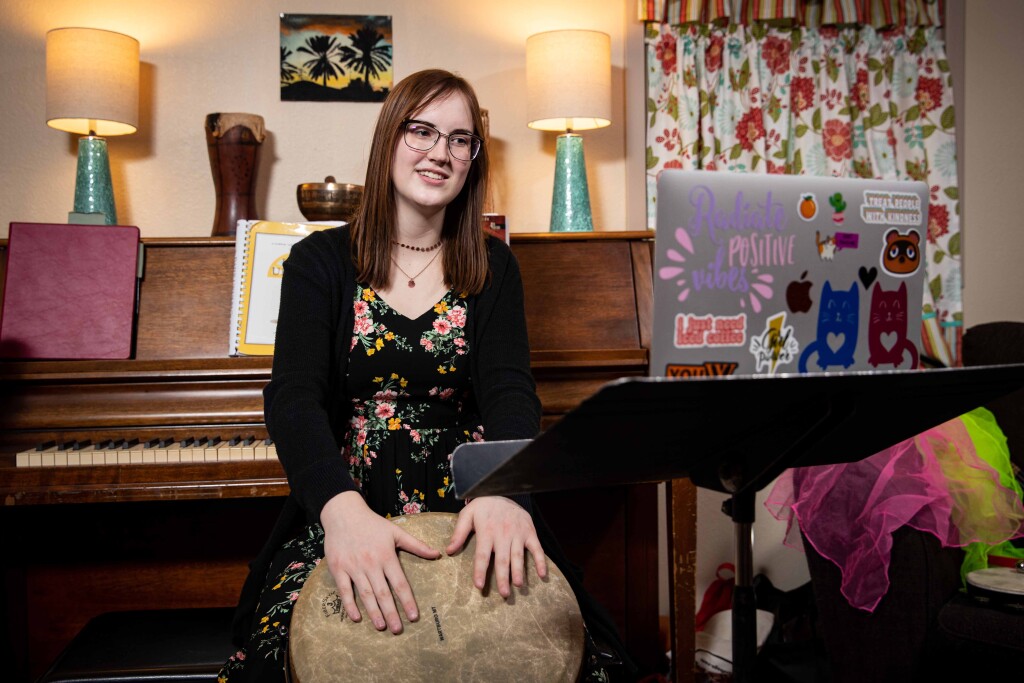
By Katie Hirv ’22
Before the COVID-19 pandemic, music therapy students at Wartburg would venture out into the Cedar Valley community to complete their practicum experiences. As part of their degree requirements, these students must complete four different practicums during their academic career, interacting with clients and leading music therapy sessions. However, as the pandemic made it unsafe for face-to-face interaction with clients, music therapy and psychology double major Natalie Camp ’22 use her laptop, a Zoom meeting, and all her usual musical instruments to ensure her practicum sessions with her clients continued.
Though the situation wasn’t ideal, it was certainly the safest for the practicum clients, students, and the greater community. And as the pandemic continued through the 2020-21 academic year, safety had to be at the forefront of every discussion.
“We’re responsible for the health of our students. That is my concern, that we make sure our students are safe and that our vulnerable clients are not compromised in any way. It’s the responsibility of the program to ensure those two things. As we entered into the summer of 2020, it was apparent to me that we might have to close the clinical program down and not send our students out into the community,” said Alpha Woodward, director of the music therapy program. “The whole point of their clinical experience is learning how to interact face-to-face with others in the moment and being ready, available, and present. That kind of training takes a while to acquire in a face-to-face experience. It was a dilemma to us on how that was going to happen.”
Telehealth offered the safest option. According to Mayo Clinic, telehealth is defined as “the use of digital information and communication technologies, such as computers and mobile devices, to access health care services remotely and manage health care.”
“At the beginning of the summer, we started looking at telehealth through Zoom, exploring that and looking at what our sister institutions were doing across the United States. We started to feel a little bit more comfortable with introducing our senior students to this reality and to telehealth. This could be something that’s with us for a while and they need to be prepared for that,” Woodward said. “It makes our students more marketable and flexible in their profession.”
Although the virtual practicum setting posed some challenges, it also brought opportunities. Telehealth allowed additional supervisors and clients to be a part of the program at a distance, rather than having to be close in proximity to Wartburg’s campus. During the 2020-21 school year, that meant that 20 students were using telehealth Zoom sessions
Due to a shortage of clients and supervisors, another 24 underclassmen were doing foundational practicum work in the classroom, which included lessons on repertoire, techniques, and practice, before going out into the field and getting their initial practicum experiences.
“Right now, most of our clients are still in the Waverly and Bremer County area. There are a few in the Cedar Falls and Waterloo area, as well and one located in the Quad Cities. Some of the specific places we’re working with are North Star Community Services in Waverly, Pathways Behavioral Health Services on campus, and some private clients here and there. We’re also working with a few retirement communities in the area,” said Barbara Ashton, music therapist in residence.
Overall, music therapy faculty believe telehealth was a positive switch for practicum experience.
“The clinical work our students did with Zoom has been surprisingly great. Going into the semester, we were all terrified about how to do this telehealth thing. Within the first couple of sessions, students were reporting that sessions were going far better than they expected. I heard from a few clients’ family members how grateful they are and how well sessions went. I’m very pleased and not surprised that our students were able to rise to the challenge,” Ashton said.
“I saw some clients actually respond better this way,” Woodward added. “We also had a lot of positive responses from the students. They really enjoyed their practicum placements through telehealth. This requires follow up on both the supervisors and students, but it seems to be a very positive experience. I’m so proud of all our supervisors, students, and faculty for adjusting to this new reality and creating a positive environment for us to continue working.”
Greta Christianson, a fourth-year music therapy student, saw firsthand the benefits the telehealth sessions can bring practicum clients.
“My favorite part of any practicum, whether it’s over Zoom or in-person, is getting to see how much joy the music brings your clients. You’re helping them express themselves when they might not otherwise get that opportunity,” Christianson said.
For Camp, telehealth seemed intimidating at first, but turned out to be a great practical experience.
“It was amazing to see you can still connect with your client over an Internet form. I was really scared that it was going to be hard to engage with the people I was working with, but music therapy, despite having to move to Zoom, is still really beneficial and needed now more than ever. Making someone’s day and knowing you make it better is worth it to me, no matter what format,” Camp said.
